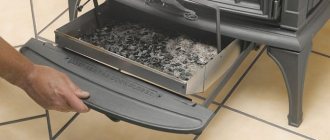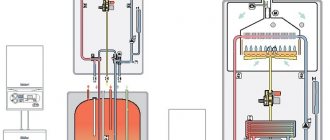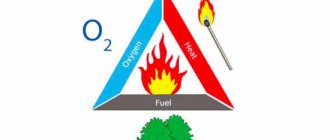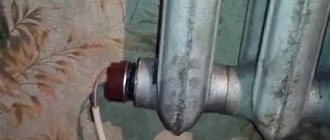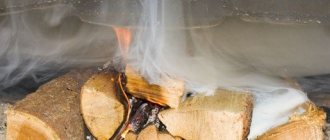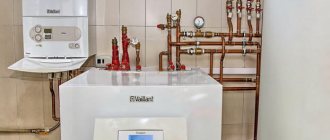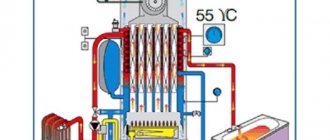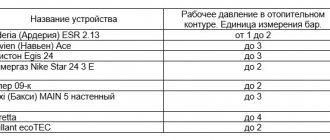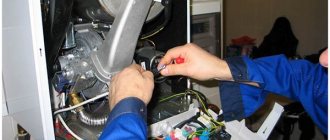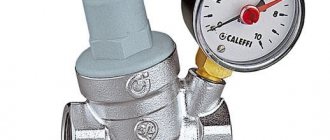It is impossible to completely get rid of condensate, but it is possible to reduce its amount. The formation of condensation can last for 20-25 minutes after lighting (if the boiler is tied up correctly), and last a long time if the boiler is tied up incorrectly. There are other reasons for the formation of condensate masses, the elimination of which will help reduce them and extend the service life of the boiler.
Common causes of condensation
Condensation occurs from the combustion of biomass (wood, fuel briquettes), rich in moisture. Any boiler manufacturer indicates in the operating instructions that the boiler should be fired with dry material.
Often this point is ignored, and the boiler is heated with whatever is necessary. Water is also present in the air entering the combustion chamber.
Under the influence of high temperatures, water vapor combines with fuel combustion products and soot. Becoming heavier than air, this mass begins to settle on all surfaces with which it comes into contact.
Other causes of condensation
Another reason for the rapid appearance of condensation is the walls of the chimney. Or rather, their thickness. To avoid problems in the future, the chimney in the house is built with a wall thickness of at least 120 mm. This thickness is equal to half a brick. At the same time, the outer part of the chimney is 380 mm thick, in other words, one and a half bricks.
It is worth considering that if the walls are smaller than the specified values, the worse they retain heat and let the cold through faster. To put it differently, the chimney cools faster due to environmental influences than it is heated by the operation of the boiler. In this case, condensation forms, and in large quantities.
It is worth noting that the chimney (outer part) is additionally insulated. This can be done by choosing from a range of building materials.
In addition, insulation and subsequent finishing can help improve the aesthetics of the structure, giving the chimney and exterior of the house a better appearance.
The causes of condensation include:
- Violation of technology - starting the boiler at full power after idle time, while the chimney is not heated;
- Condensation forms when the chimney has not been cleaned for a long time (with poor permeability, steam accumulates);
- A high difference in temperature outside and in the chimney, poor protection of the latter from environmental influences lead to the appearance of moisture on the walls;
- Using low-quality fuel. When using solid fuels – wet or raw;
- Violation in the chimney structure.
The effect of condensation occurs when the draft is incorrectly calculated or there is a problem with it.
What is condensate? Essentially, it is a liquid that settles on the walls of the chimney over time. This happens because, as exhaust gases move through the pipe, they are cooled and the steam included in their composition turns into condensate, which settles inside the chimney. In addition, gas and condensate are mixed, resulting in the formation of acid. Its type depends on the fuel used, that is, it can be salt, sulfur or nitrogen.
Removing condensate will protect the chimney from destruction
Gas, and other heating appliances, except electric ones, have the following property - the products of fuel combustion have a low temperature and after some time, the steam they contain begins to settle on the walls of the chimney. This is how condensation forms. If its insides are made of metal, then moisture will not stay on the surface for long and will gradually flow down. In this case, you will need a condensate collector for the chimney, into which moisture will flow, from where it can be removed.
But if the surface is made of brick, then condensation will certainly accumulate on the porous surface of the pipe. The result of this may be the destruction of the chimney.
Condensate on the boiler heat exchanger
Condensate is weak solutions of low concentration acids that interact with the metal walls of the boiler.
During these reactions, the walls of the boiler are slowly corroded. Drops of condensate are deposited on the walls of the heat exchanger. Until they dry, soot sticks to them and under the influence of high temperature is sintered into a durable heat-protective crust.
This crust significantly reduces the efficiency of the boiler, because the heated gases cannot transfer heat to the metal heat exchanger. The crust is extremely difficult to clean from the walls of the combustion chamber, especially if the boiler has a developed and shaped heat exchange system. To avoid such deposits, it is necessary to carry out routine maintenance on the boiler once a month to remove tar and tar.
This is done using a metal brush and spatula. If the crust has stuck firmly, then you need to melt the boiler and add a special powder to the firebox, which increases the combustion temperature. Under the influence of high temperatures, tar burns out and turns into easily removable ash. It is not recommended to carry out this procedure yourself.
Cleaning a solid fuel boiler with a spatula
This should be done by a specialist. Otherwise, the coolant temperature may rise above 100 degrees, which will inevitably lead to failure of the piping if it is made of plastic pipes. Condensation forms inside the boiler at the moment of ignition. This process lasts until the walls of the boiler warm up and the water begins to turn into steam, thereby passing the “dew point”.
Condensation falls in the form of water droplets on all surfaces of the boiler, both internal and external. If the boiler walls are poorly protected from corrosion, this can lead to rusting of the metal and the appearance of through holes.
Video: Cleaning a solid fuel boiler
Condensation inside the chimney
If the chimney is not made correctly, 50-60% of the condensate released during the combustion process enters the boiler through it.
Condensation in the chimney
As a rule, for solid fuel boilers, the chimney is made independently, ignoring all the requirements for its manufacture. To ensure that the chimney exhaust device is manufactured correctly, here are these rules:
- The diameter of the chimney must correspond to the diameter of the outlet in the boiler.
- After exiting the boiler, the chimney should be inclined. The length of the inclined pipe must be at least a meter, after which it can be mounted vertically.
- At the junction of the inclined and vertical parts, it is necessary to install a drainage part that goes down and is equipped with a drainage device.
- It is necessary to provide a detachable section on the vertical part of the chimney to facilitate cleaning the chimney from soot.
- The entire area of the pipe must be covered with asbestos mats in a heat-protective reflective shell.
- It is advisable to protect the top of the chimney from the penetration of moisture in the form of precipitation.
- The height of the chimney pipe must be at least 5 meters
.
Ideally such a chimney would look like this. From the boiler standing near the wall, a pipe in an asbestos jacket was laid through the wall to the street at an angle. On the street, along the wall, the chimney rises up, also wrapped in asbestos mats.
A drainage channel with a tap goes down from the street corner connection. The vertical part of the chimney is equipped with a removable section and a “cap” at the top.
There is another way to avoid condensation in the chimney pipe - install an industrially manufactured stainless steel chimney. This is the best solution in terms of durability, functionality and aesthetic appearance.
The stainless steel chimney is polished inside, and unlike a conventional metal pipe, it has less abrasiveness of the material. Consequently, soot adhesion on it occurs less intensely.
A layer of heat-resistant insulation is laid between the outer and inner shell of such a chimney, which removes the dew point and prevents the formation of condensation. Stainless steel heats up very quickly, due to which draft in the boiler is formed instantly, which eliminates smoke in the room when the boiler is fired up.
To make a stainless steel chimney ( only AISI 304
) served for a long time and reliably, you should pay attention to the butt joints of the pipe (must be welded) and the insulation material (must be tightly laid and have a flammability certificate).
Installation and dismantling of the elements of such a chimney when cleaning it is simple and does not require special skills.
Common problem
The big problem is the appearance of condensation in the chimney. It represents droplets of liquid that form on any cooled surfaces (bottles with liquid, metal sheets, etc.). They appear due to the condensation of steam present in the airspace. You can see this phenomenon with your own eyes on the walls of the kitchen and bathroom. We learned to fight this phenomenon, and even turned it into a good thing. But in the case of a chimney, condensation is an unpleasant side effect of improper design or organization of the combustion product removal system, which, moreover, gives negative consequences after its appearance.
Condensation on the surface is a clear liquid (water), which is easy to remove and harmless.
In the case of a gas boiler, it poses a serious threat that interferes with the normal functioning of the system, but also threatens damage to the device itself and even failure of the gas boiler.
This effect should be avoided, and if detected in the chimney, condensate should be eliminated, as well as the causes of its occurrence.
Condensation under the boiler
Such condensation may fall on the outer surface of the boiler bottom if it is not equipped with thermal protection. To a large extent, the appearance of moisture under the boiler depends on the air humidity in the room. This may result in water dripping onto the wood placed under the boiler to dry.
Using such wood as fuel will lead to increased formation of condensation inside the boiler. To eliminate this phenomenon, you need to insulate the bottom with heat-resistant foil insulation, which in turn will increase the efficiency of the boiler, but will slow down the process of drying the firewood.
How to get rid of moisture condensation?
There is only one answer to this question: it cannot be completely eliminated, but it is possible to reduce its concentration. There are several ways you can do this.
1. When operating fuel-burning appliances, it is necessary to use fuel that has been dried to a certain moisture level. For this purpose, special filters are installed in boilers operating on gas or diesel fuel to prevent moisture from entering the fuel. When using firewood or coal, it makes sense to carry out drying procedures or, conversely, moistening;
2. When constructing a chimney system, it will be necessary to insulate the structure. This will move the point of condensation formation. In addition, thermal insulation will not allow the pipe to cool quickly, since contact between the external environment and its surface will be minimized;
3. Cleaning the pipe from soot and carbon deposits. This will lead to the free movement of combustion waste, and the draft will be restored to the required level;
4. Installation of a device called a deflector on the head of the pipe. It will protect the pipe from precipitation and increase traction;
5. Installation of a condensate collector for the chimney in places where excess moisture accumulates.
If the homeowner follows these simple rules when constructing and operating a chimney for a condensing gas boiler or any other model, then the service life of this device will be extended.
Preventive measures
We’ll talk about how to get rid of condensation in a ventilation pipe below. Preventive measures must be taken at the design stage of the chimney system. Namely, it is necessary to provide the following measures, the use of which will reduce the likelihood of destruction of the chimney from the action of aggressive substances formed during the movement of fuel combustion waste inside it. Such measures include:
- provide for the installation of a pipe made of corrosion steel inside a brick chimney (lining). This will reduce aerodynamic drag and prevent structural damage from condensation;
- collect condensate from the chimney;
- provide for the possibility of installing thermal insulation;
- provide sealing of sleeve joints;
- provide for the possibility of installing a condensate drain.
Important! By installing a corrosion-resistant steel sleeve inside a brick chimney, you must be prepared for the fact that the draft will decrease. When working to seal seams, it is necessary to carefully select the sealant, since some brands “petrify” and crack with use.
Steam trap - some properties
Smoke exhaust systems that are installed in modern suburban buildings are quite complex engineering structures. The overall efficiency of the chimney depends on the quality of the materials used during construction, compliance with technological rules and instructions. That is, if the necessary draft is provided and the internal cavities of the pipe do not have obvious obstacles, then such a design can last for decades at maximum efficiency of the boiler equipment.
If errors are made during the assembly of the structure, you can be sure that combustion products will enter the room. In addition, these errors can lead to a building fire.
Based on the above, we can conclude that one of the main problems of chimney exhaust systems is the formation of condensate containing chemically aggressive substances (sulfuric, hydrochloric and nitric acids).
To reduce this impact and improve the efficiency of the system as a whole, it makes sense to purchase and install a steam trap. There are several versions of this device. As a rule, a corrosion-resistant steel alloy is used to manufacture this part. The thickness of the metal ranges from 0.5 to 0.8 mm.
But recently, these devices made of heat-resistant ceramics have begun to appear on the market.
In its shape, it resembles an inverted watering can, the spout of which is directed downwards. It is through this that the accumulated condensate is drained. The accumulated condensate is removed without any release of steam. This reduces the likelihood of a phenomenon such as water hammer occurring.
The condensate trap is classified as a phase separating valve. It is designed for automatic separation of steam and exhaust gases. By the way, these fittings include air vents and oil separators. As a rule, they are installed at the output of thermal appliances. When assembling the chimney inside the house, it can be installed immediately after the heating device. In particular, one of the places for its installation is a tee.
When constructing a chimney outside the house, along the wall, this part is installed after exiting the wall. The use of this device allows for more efficient use of the generated heat and, as a result, increases the efficiency of the heating device.
This device means that it will be installed at the base of each vertical chimney run. The design of the condensate collector includes grooves through which moisture flows into the sump.
Condensation in a chimney is a phenomenon that sooner or later leads to irreparable consequences. But if the homeowner takes all measures to minimize the amount of condensate on the chimney pipe at the stage of design and construction of the stove, then he will not only ensure maximum fire safety of the building, but will save on future modifications of the chimney system.
- The Chelyabinsk manufacturer can be trusted 100%
- the company is invited to collective stands in the Chelyabinsk region to participate in major international exhibitions, the company invests in production development (the Japanese KUKA robotic welding complex was launched in 2021), the company employs specialists who love their work. - START
are really
very durable boilers
(6mm thick steel), and they retain their characteristics throughout their entire service life. Pay attention to the weight of the boiler. - removal
(maximum efficiency).
This is not just a firebox with a pipe into which heat escapes ( your money
), but a multi-pass heat exchanger that transfers heat to the heating system. - Only reliable technical information
(we are bad at telling fairy tales) - boiler power and burning time are guaranteed real figures, and under ideal conditions, boiler power can be even higher. And at the same time, there are no pitfalls - there are no blocked automation settings or removal of the warranty during self-installation. - Attractive price
for a European quality boiler.

